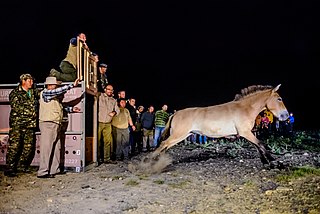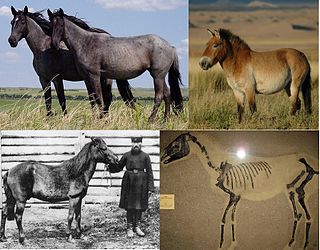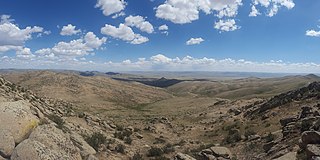
Przewalski's horse, also called the takhi, Mongolian wild horse or Dzungarian horse, is a rare and endangered horse originally native to the steppes of Central Asia. It is named after the Russian geographer and explorer Nikolay Przhevalsky. Once extinct in the wild, since the 1990s it has been reintroduced to its native habitat in Mongolia in the Khustain Nuruu National Park, Takhin Tal Nature Reserve, and Khomiin Tal, as well as several other locales in Central Asia and Eastern Europe.

Species reintroduction is the deliberate release of a species into the wild, from captivity or other areas where the organism is capable of survival. The goal of species reintroduction is to establish a healthy, genetically diverse, self-sustaining population to an area where it has been extirpated, or to augment an existing population. Species that may be eligible for reintroduction are typically threatened or endangered in the wild. However, reintroduction of a species can also be for pest control; for example, wolves being reintroduced to a wild area to curb an overpopulation of deer. Because reintroduction may involve returning native species to localities where they had been extirpated, some prefer the term "reestablishment".

The Bayankhongor Province or Bayanhongor Aimag is one of the 21 aimags (provinces) of Mongolia. It is located in the southwest of the country and, at 116,000 square kilometers, it is one of the largest aimags. The capital of the aimag shares the provincial name, Bayankhongor.

The Wilder Institute/Calgary Zoo is located in Bridgeland, Calgary, Alberta, Canada, just east of the city's downtown and adjacent to the Inglewood and East Village neighborhoods. It is accessible via Calgary's C-Train light rail system, by car via Memorial Drive, and by bicycle and footpath via the Bow River pathway. A large portion of the zoo is located on St. George's Island in the Bow River.

Prague Zoological Garden is a zoo in Prague, Czech Republic. It was opened in 1931 with the goal to "advance the study of zoology, protect wildlife, and educate the public" in the district of Troja in the north of Prague. In 2013, the zoo occupied 58 hectares with 50 hectares in use for exhibits, and housed around 5,000 animals from 676 species, including 132 species listed as threatened.

Captive breeding, also known as captive propagation, is the process of keeping plants or animals in controlled environments, such as wildlife reserves, zoos, botanic gardens, and other conservation facilities. It is sometimes employed to help species that are being threatened by the effects of human activities such as climate change, habitat loss, fragmentation, overhunting or fishing, pollution, predation, disease, and parasitism.

The Mongolian wild ass, also known as Mongolian khulan, is the nominate subspecies of the onager. It is found in southern Mongolia and northern China. It was previously found in eastern Kazakhstan and southern Siberia before being extirpated there through hunting. As of 2015, the Mongolian wild ass is listed as Near Threatened by the IUCN. Current population estimates are approximately 42,000 individuals in Mongolia and around 5,000 individuals in Northern China.

The wild horse is a species of the genus Equus, which includes as subspecies the modern domesticated horse as well as the endangered Przewalski's horse. The European wild horse, also known as the tarpan, that went extinct in the late 19th or early 20th century has previously been treated as the nominate subspecies of wild horse, Equus ferus ferus, but more recent studies have cast doubt on whether tarpans were truly wild or if they actually were feral horses or hybrids.

The Mongolian horse is the native horse breed of Mongolia. The breed is purported to be largely unchanged since the time of Genghis Khan. Nomads living in the traditional Mongol fashion still hold more than 3 million animals, which outnumber the country's human population. In Mongolia, the horses live outdoors all year, dealing with temperatures from 30 °C (86 °F) in summer down to −40 °C (−40 °F) in winter, and they graze and search for food on their own. The mare's milk is processed into the national beverage airag. Some animals are slaughtered for meat. Other than that, they serve as riding and transport animals; they are used both for the daily work of the nomads and in horse racing.

The Mongolian-Manchurian grassland, also known as the Mongolian-Manchurian steppe or Gobi-Manchurian steppe, in the temperate grassland biome, is an ecoregion in East Asia covering parts of Mongolia, the Chinese Autonomous region of Inner Mongolia, and Northeast China.

Hustai National Park, located in the Khustai Mountains of Töv Province, is a national park of Mongolia. It is also known as Khustain Nuruu National Park. The Tuul River runs through the park.

The Persian fallow deer is a deer species once native to all of the Middle East, but currently only living in Iran and Israel. It was reintroduced in Israel. It has been listed as endangered on the IUCN Red List since 2008. After a captive breeding program, the population has rebounded from only a handful of deer in the 1960s to over a thousand individuals.

Korkeasaari Zoo, also known as Helsinki Zoo, is the largest zoo in Finland, located in Helsinki. The zoo was first opened in 1889. Today it is operated by a nonprofit foundation.
Great Gobi B Strictly Protected Area is a nature reserve in Gobi desert, situated in the southwestern part of Mongolia at the border with China. A similar reserve in a drier part of the Gobi exists further to the east - the Great Gobi A Strictly Protected Area.

The Turkmenian kulan, also called Transcaspian wild ass, Turkmenistani onager or simply the kulan, is a subspecies of onager native to Central Asia. It was declared Endangered in 2016.

The wildlife of Mongolia consists of flora, fauna and funga found in the harsh habitats dictated by the diverse climatic conditions found throughout the country. In the north, there are salty marshes and fresh-water sources. The centre has desert steppes. In the south, there are semi deserts as well as the hot Gobi desert in the south, the fifth-largest desert in the world.
The Great Gobi A Strictly Protected Area is a nature reserve in the Gobi Desert, situated in the southwestern part of Mongolia at the border with China. A similar reserve in the Gobi exists farther to the west - the Great Gobi B Strictly Protected Area. Both reserves form one unit, the Great Gobi Strictly Protected Area (SPA), which encompasses a total of 53,000 km2 (20,000 sq mi). Great Gobi A is one of the last refuges for critically endangered animals such as the wild Bactrian camel and the Gobi bear.

Milovice Nature Reserve is a nature reserve next to the towns of Milovice and Benátky nad Jizerou in Nymburk District, Central Bohemian Region, Czech Republic. Established in 2015, the area is administered by the Česká krajina o.p.s. organization, as a part of Evropsky významná lokalita Milovice-Mladá CZ0214006 protected area, part of the European Union project Natura 2000. This reserve is a pioneering project of cooperation between several scientific bodies and draws support from many organizations and private sponsors.

Miroslav Bobek is a Czech natural scientist and manager, since 2010 he has been the director of Prague Zoo and from 2014 to 2016 he was also president of the Union of Czech and Slovak Zoos. He worked for a long time in Czech Radio, where he became famous for his show "Revealed", in which he observed the life of the gorillas at Prague Zoo in the form of a reality show.
The Altyn Dala Conservation Initiative (ADCI) is a longstanding collaborative partnership of national and international NGOs and the Government of Kazakhstan dedicated to safeguarding and restoring the diverse steppe, desert, and wetland ecosystems of Kazakhstan, for the benefit of both wildlife and people. Geographically, the focus is on the parts of the historical range of the Saiga antelope which are still re-occupiable.



















